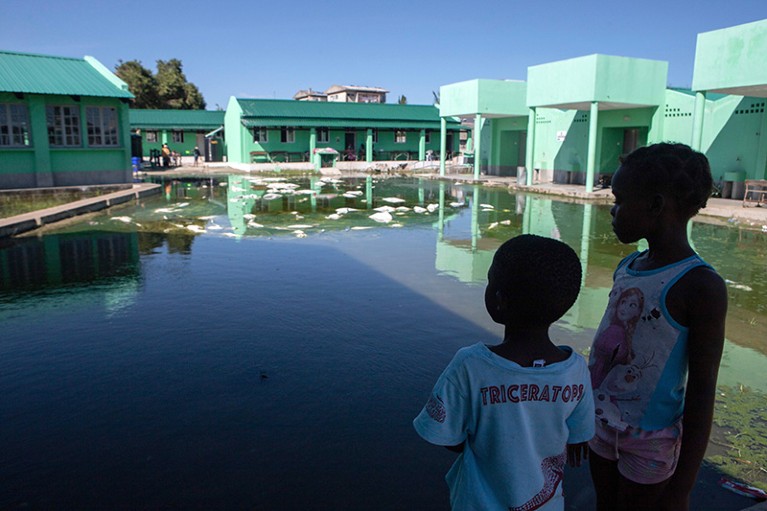
A flooded school in Mozambique after Cyclone Eloise in January. Disrupted education can harm lives, livelihoods and economies for decades.Credit: Alfredo Zuniga/AFP via Getty
Climate change is provoking ever-more-extreme events, from storms and droughts to floods and cyclones. The risk of such hazards increases as the planet warms, and these risks interact across many environmental and social systems. A heatwave can spark forest fires, which lead to air pollution, thus damaging public health. Drought-wrecked harvests can result in food-price volatility, which can increase social unrest or migration.
Yet these domino effects are barely considered in most countries’ strategies for achieving the United Nations Sustainable Development Goals (SDGs) by 2030.
Set in 2015, the 17 SDGs range from ‘zero hunger’ (SDG2) to ‘affordable and clean energy’ (SDG7) and ‘sustainable cities and communities’ (SDG11). Many countries that are working hard to attain these goals insufficiently consider the impact of extreme weather. Take Germany, a leader on climate action in many ways. Its 2018 strategy on sustainable development runs to 60 pages1, yet the word ‘disaster’ appears only once. There is no analysis of the ramifications of an increase in such events.
Although many people are now aware that climate change is making fires, floods, heatwaves and storms more frequent, more severe or both, this knowledge isn’t changing policy or research enough2. Part of the problem is perception. Future catastrophes feel unreal to decision-makers, as we’ve experienced with so many governments’ lack of pandemic preparedness, despite years of warning that something similar to COVID-19 was a case of when, not if3. Other obstacles are inadequate national and international governance, and communication challenges. The research community has not yet provided the interdisciplinary modelling required to quantify these complex cascades.
Reset Sustainable Development Goals for a pandemic world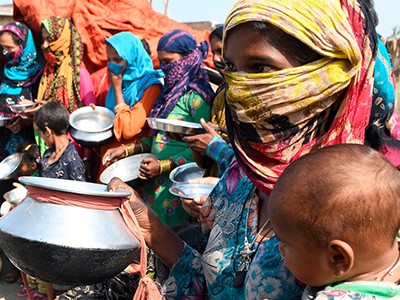
As a consequence, many efforts to attain the SDGs will, like a house of cards, fall at the first tremor. Witness the way in which the pandemic has set back progress on global poverty, hunger, childhood immunizations, educational inequalities, advancements for women and girls, and more4. Our global efforts need to be much more robust to the changing and interconnected nature of risk in a warming world.
Good preparation is not just a matter of money and engineering, but of knowledge and foresight. Unfortunately, the ways in which different risks from climate extremes are interlinked and dependent on each other are among the greatest potential causes of future catastrophes5,6. They are also some of the most under-studied. This cuts across all aspects of social and physical sciences.
What now? Researchers must create models that are more understandable and useful to policymakers. When possible, SDG targets and indicators should be redesigned to capture vulnerability to heatwaves, fires, droughts, floods, hurricanes, mudslides and more. And politicians need to be convinced to invest in precautionary measures and adaptation.
Recognizing risk
The fact that climate extremes imperil development was recognized by the UN Conference on Environment and Development in 1992. It is also noted in the 2015–30 Sendai Framework, the global agreement to “reduce and prevent disaster risks across the globe”. Yet there has been little progress on these ideas.
The United States can help the IMF to rethink how it lends
There are examples of preparedness. Flood barriers in the Netherlands and in Venice, Italy, are designed to protect against future sea-level rise. But the idea of flooding from rising sea levels is easier to grasp than are the effects of complex and compounding events, which are sometimes counter-intuitive and connected over long distances in both space and time (see Supplementary information).
For instance, in 2018, heavy rains that fell one month after wildfires on steep slopes in southern California caused fatal mudflows. Another example is a wet winter in which there is a lot of plant growth — this can be a big fire risk if a hot and dry summer follows, because of the build-up of forest fuel7. Protections against river floods need to consider droughts as well as high water flows, because dry material in dykes can shrink, crack and become unstable8.
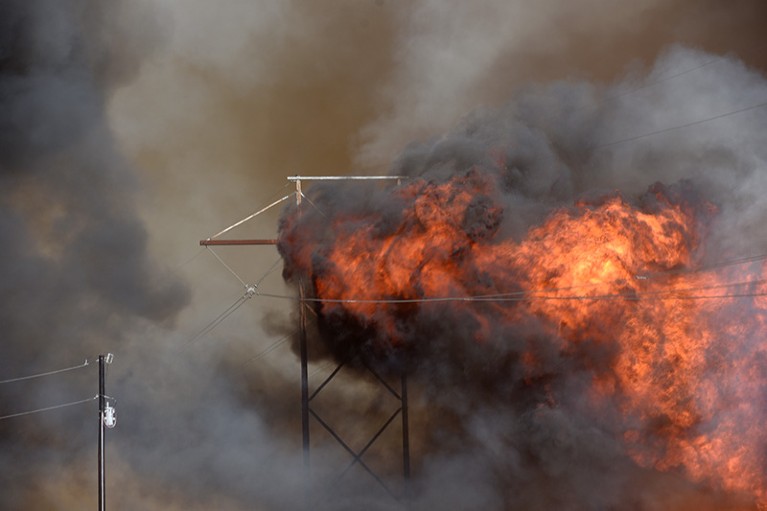
A 2018 wildfire caused power lines in Oklahoma to explode. Such infrastructure collapse has far-reaching ripple effects.Credit: Nick Oxford/Reuters
Extreme weather can fuel a vicious cycle of vulnerability — physical, social and economic. In Mozambique, for example, droughts and floods in the mid-2000s that destroyed infrastructure and crops had a domino effect on housing, jobs, education and social ties. To recover, families had to sell their homes or land, or needed to put their children to work. This came at the cost of longer-term income and well-being. National food consumption fell by more than one-quarter, ill health in children increased fourfold in flooded areas, school participation fell drastically and poverty levels increased by up to 17.5 percentage points9.
These cascades across different systems have received concentrated academic attention only in the past few years, and the social aspects, in particular, are still not well understood10.
Modified models
Most current models cannot forecast these complexities. They might not allow for interactions between farming, ecosystems, households, companies, financial institutions, social cohesion and governance. All of this should be explicitly modelled, and the indirect long-term effects quantified.
This is hugely challenging. Agent-based modelling can help. In this approach, the interactions of autonomous agents (individuals, organizations or groups) are modelled as they react to changing conditions. Critics have long argued that such models are too complex and uncertain to yield reliable results. In our view, the technique is now coming of age, thanks to huge amounts of data, improved artificial intelligence (AI) and greater computational power.
Time to revise the Sustainable Development Goals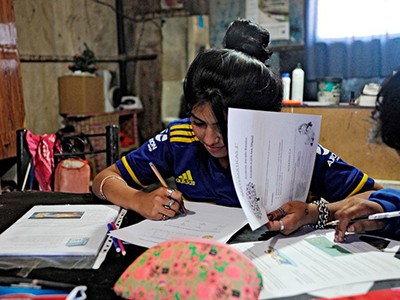
Such models have been shown to work retrospectively on the somewhat simpler systems of past societies. One example is how the Cahokia people responded to repeated droughts11 in midwestern North America between ad 900 and 1200. These models have also shown potential in estimating the emerging risks of major floods in Austria. Researchers mapped out the impacts of flooding on building and infrastructure value, credit provision and government finances — factors that would impede reconstruction after a disaster12.
Whatever the tools, more researchers must map complex social systems using economic and census data. Such an approach needs harmonized data at high resolution (county or state level), but this information is often inadequate. Importantly, big-data efforts need to be combined with qualitative work by social scientists — including anthropologists, economists, historians and archaeologists — that is culturally sensitive and place-specific.
Data science and AI are playing an increasingly important part in disaster preparedness, response and recovery. For instance, analysing satellite images and other Earth-observation data can help to pinpoint where to deliver humanitarian aid most efficiently, and AI supports early-warning systems and risk assessment. An example of the interplay of good data, models and governance was the early warning, preparedness and evacuation of around three million people in India and Bangladesh before Cyclone Amphan struck in May 2020. There is plenty of scope for developing and using AI to anticipate long-term vulnerabilities.
Improved indicators
Alongside modelling efforts, researchers should help to rework SDG indicators so that they are better at tracking progress towards resilient sustainable development.
Good indicators account for variability and vulnerability. For example, one of the metrics for success in achieving SDG2 (zero hunger) is the domestic food price volatility index. This reports the standard deviation around the mean of the price index of cereals, vegetable oil, dairy, meat and sugar. Thus, it takes into account the certainty and stability of food availability from year to year and within each year, which is affected by climate extremes. This variability is important for capturing the effects of temporary food scarcity, which disproportionately affects poor people because they spend a large share of their income on food. Yet this indicator is regularly reported only nationally — not regionally or locally, where variability needs to be captured.
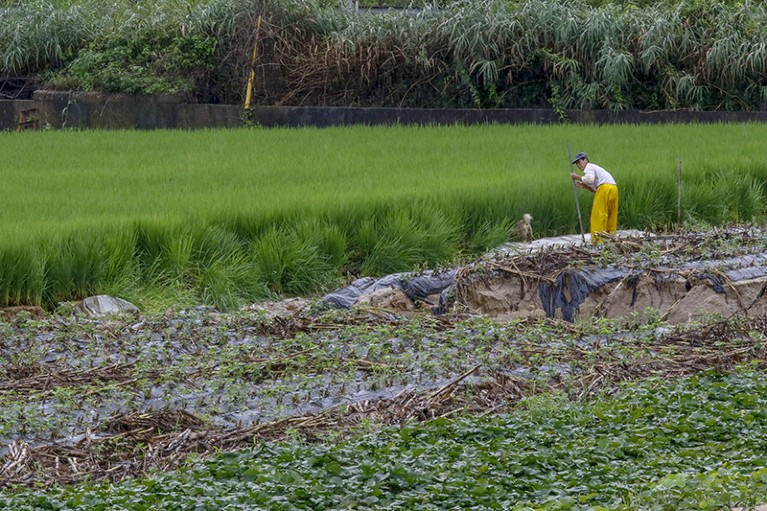
A farmer restores his rice field in South Korea after torrential rains and flooding during the prolonged monsoon season of 2020.
Most other SDG targets and indicators ignore risk and variability entirely. Metrics such as the “proportion of water bodies with good water quality” and “annual mean levels of fine particulate matter” are measured only as yearly averages. Adding variability measures would be an important first step towards revealing vulnerability in those systems and tracking how that changes as the world warms.
In the past few years, researchers have tried to map out the ‘sustainome’ — the web of interactions between SDGs (see Fig. 1 of ref. 13, for example). Important work such as this helps to capture synergies and trade-offs between various SDGs in different nations. Along these lines, SDG indicators — and Sendai indicators for disaster risks — should be woven together into compound indicators of systemic risk. More work is needed to understand how to achieve this and explore which models and data might help.
Targeted investment
Creating models of interacting risks that are realistic, tracking vulnerability and putting figures on such risks are all crucial in helping policymakers and investors to decide where to channel money and attention.
Many researchers are focused on breeding more-nutritious crops to help achieve zero hunger, for example. They need to know whether future droughts will lead to the failure of those varieties, or which crops, combinations or practices will adversely affect biodiversity, ecosystem resilience or the roughly 500 million smallholder farmers in ways that influence other SDGs. System models fed with observational data will help to identify which factors should be modified to increase resilience.
Heed blame for extreme weather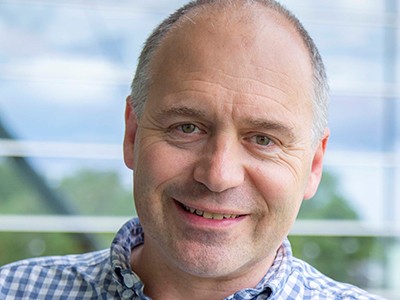
Large investments in resilience measures can be difficult for politicians to justify to electorates because there are often no immediate returns, and the timing and magnitude of future extreme events are unknown. But avoiding such spending is much more costly in the long run, as shown by the current pandemic14.
A 2019 report on low- and middle-income countries found that investing 3% more than business-as-usual levels in the infrastructures of three sectors — power, water and sanitation, and transport — would make those infrastructures more resilient to extreme events. The report found that this would pay off in the long run by an average of US$4 for every $1 invested — and would have greater pay-offs as climate extremes worsen15. Such improvements to infrastructure protect against direct damage and against subsequent disruptions to economic activities. In Hamburg, Germany, for example, an investment of 2.2 billion (US$2.6 billion) in flood protection after a 1962 storm surge is estimated to have avoided losses of more than 20 billion since then (see go.nature.com/3sx8ren).
Luckily, risk assessment does not need to be reinvented. It is mature in the insurance industry, such as in the context of earthquake hazards. The challenge now is to model, quantify and accommodate the changing risks and far-reaching impacts of the extreme weather events that are inevitable in a warming world — and the sooner the better.

 The United States can help the IMF to rethink how it lends
The United States can help the IMF to rethink how it lends
 Time to revise the Sustainable Development Goals
Time to revise the Sustainable Development Goals
 Reset Sustainable Development Goals for a pandemic world
Reset Sustainable Development Goals for a pandemic world
 Heed blame for extreme weather
Heed blame for extreme weather
 Droughts, heatwaves and floods: How to tell when climate change is to blame
Droughts, heatwaves and floods: How to tell when climate change is to blame





